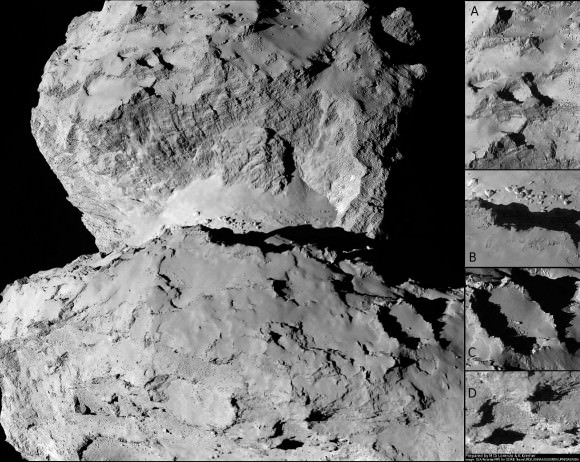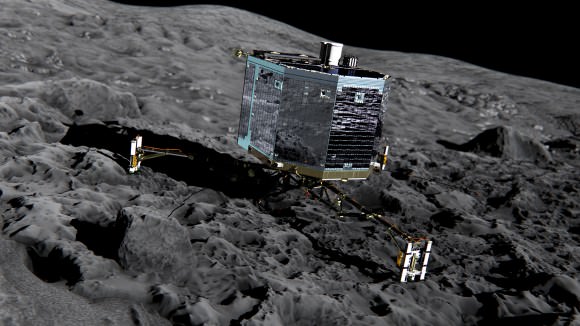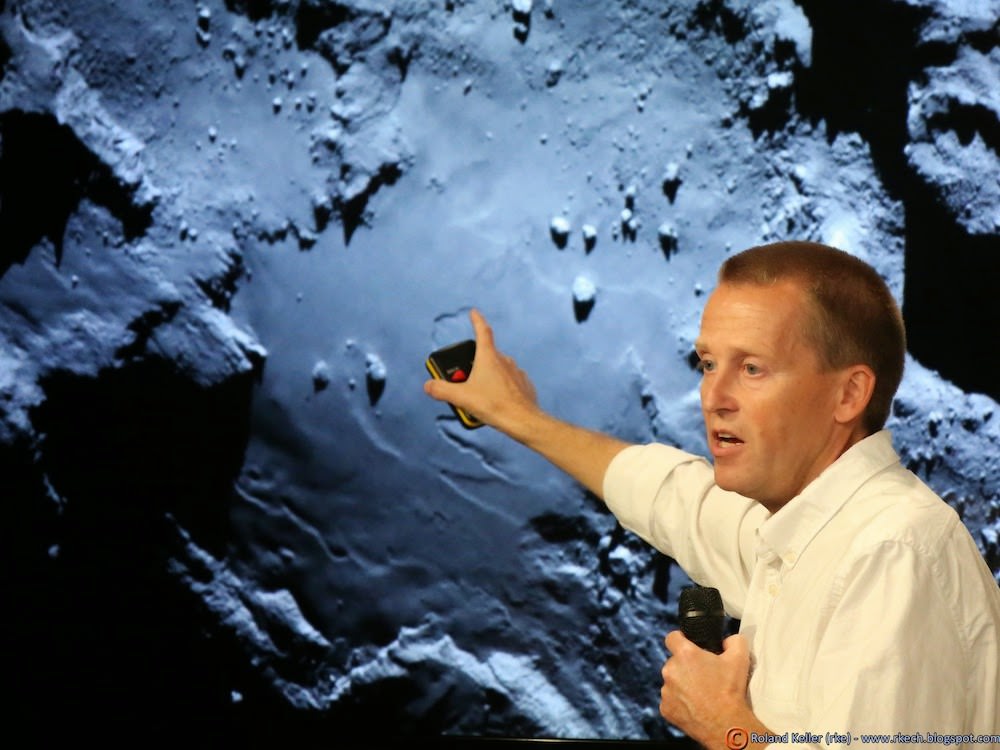Animation Caption: Possible landing sites on Comet 67P/Churyumov-Gerasimenko. The model shows the illumination of the comets surface and regions under landing site consideration for the Philae lander on board ESA’s Rosetta spececraft . Credit: CNES
“The race is on” to find a safe and scientifically interesting landing site for the Philae lander piggybacked on ESA’s Rosetta spacecraft as it swoops in ever closer to the heavily cratered Comet 67P/Churyumov-Gerasimenko since arriving two weeks ago after a decade long chase of 6.4 billion kilometers (4 Billion miles).
Rosetta made history by becoming the first ever probe from Earth to orbit a comet upon arrival on Aug. 6, 2014.
The probe discovered an utterly alien and bizarre icy wanderer that science team member Mark McCaughrean, of ESA’s Science Directorate, delightedly calls a ‘Scientific Disneyland.’
“It’s just astonishing,” he said during a live ESA webcast of the Aug. 6 arrival event.
Now, another audacious and history making event is on tap – Landing on the comet!
To enable a safe landing, Rosetta is moving in closer to the comet to gather higher resolution imaging and spectroscopic data. When Rosetta arrived on Aug. 6, it was initially orbiting at a distance of about 100 km (62 miles). As of today, carefully timed thruster firings have brought it to within about 80 km distance. And it will get far closer.
Right now a top priority task for the science and engineering team leading Rosetta is “Finding a landing strip” for the Philae comet lander.
Philae’s landing on comet 67P is currently scheduled for Nov. 11, 2014. The 100 kg lander is equipped with 10 science instruments
“The challenge ahead is to map the surface and find a landing strip,” said Andrea Accomazzo, ESA Rosetta Spacecraft Operations Manager, at the Aug. 6 ESA webcast.
The team responsibility for choosing the candidate sites comprises “the Landing Site Selection Group (LSSG), which comprises engineers and scientists from Philae’s Science, Operations and Navigation Centre (SONC) at CNES, the Lander Control Centre (LCC) at DLR, scientists representing the Philae Lander instruments, and supported by the ESA Rosetta team, which includes representatives from science, operations and flight dynamics,” according to an ESA statement.
This week the team is intensively combing through a preliminary list of 10 potential landing sites.
Over the weekend they will whittle the list down to five candidate landing sites for continued detailed analysis.
ESA will announce the Top 5 landing site candidates on Monday, Aug. 25.

This image of comet 67P/Churyumov-Gerasimenko shows the diversity of surface structures on the comet’s nucleus. It was taken by the Rosetta spacecraft’s OSIRIS narrow-angle camera on August 7, 2014. At the time, the spacecraft was 65 miles (104 kilometers) away from the 2.5 mile (4 kilometer) wide nucleus. Credit: ESA/Rosetta/MPS for OSIRIS Team MPS/UPD/LAM/IAA/SSO/INTA/UPM/DASP/IDA/Enhanced processing Marco Di Lorenzo/Ken Kremer
The decision rests on the results of Rosetta’s ongoing global mapping campaign, including high resolution imaging from the OSIRIS and NAVCAM cameras and further observations from the other science instruments, especially MIRO, VIRTIS, ALICE, GIADA and ROSINA.
The surface criteria for a suitable landing site include day time landing illumination, a balance between day and night to allow the solar panels to recharge the batteries, avoiding steep slopes, large boulders and deep crevasses so it doesn’t topple over.
Of course the team also must consider the comet’s rotation period (12.4 hours) and axis of rotation (see animation at top). Sites near the equator offering roughly equal periods of day and night may be preferred.
The selection of the primary landing site is slated for mid-October after consultation between ESA and the lander team on a “Go/No Go” decision.
The three-legged lander will fire two harpoons and use ice screws to anchor itself to the 4 kilometer (2.5 mile) wide comet’s surface. Philae will collect stereo and panoramic images and also drill 23 centimeters into and sample its incredibly varied surface.

Read an Italian language version of this story by my imaging partner Marco Di Lorenzo – here
Stay tuned here for Ken’s continuing Earth and Planetary science and human spaceflight news.


FYI, Rosetta is not yet orbiting comet 67P/Churyumov-Gerasimenko. It has rendezvoused with the comet, and is traveling in the same orbit and is very close, but has not yet entered orbit around the nucleus. I can’t find out exactly when that’s scheduled to happen, but they do plan to orbit about 30 km above the surface before the scheduled landing in November.
Here’s the path Rosetta is/will follow:
I don’t think it can orbit the comet, the gravity is way too low. Not “orbit” in the common sense of an elliptic trajectory around the comet. It passes by in hyperbolic trajectories. If its engine doesn’t change trajectory regularly, I think twice per week now, it would fly away from the comet. Professionals seem to call such hyperbolic escape trajectories “orbits” too, which causes some confusion.
The circular-like orbits in the illustrations, I assume, will be caused by continuous rocket power, not gravity.
The gravity ‘well’ of the comet is slight, but the comet itself, as many others, are the size of some massive mountains; the gravity may be slight, but it’s there. A mass, released a meter above the surface, might take a few minutes to “fall”, but fall, it does. Rosetta’s orbit might take a couple days or more per orbit at a distance of, say, 30 km, but it will. I assume that Rosetta’s orbit will be at a comet-equatorial orbit, the easiest, and almost synchronous to the comet’s rotational velocity. At equal rotational speed, it would fall. With some slight speed, perhaps at only a few meters/second at a 20km orbit, it remains in orbit. ((->The math would be interesting!<-))
—
My question is: What types of gravity sensors are in use, and how do the sensors work? They must be **extremely** sensitive. From videos elsewhere, it was explained that the odd, more-or-less triangular descent/approach was, in part, for the detailed measurement of the comet's gravity.
Can be, I’m not an expert. But I’d be surprised if it’s possible to gravitationally orbit a 4 km diameter low density iceberg at 10 km distance.
The gravity field, I think, is measured by radio communication between Earth and the probe. They can count the number of radio waves to it, or their phase shifts and the precision is as good as the wavelengths, or even better. It’s ridiculous. That’s how they discovered the Pioneer anomaly of a billionth of a meter per second or something like that. And they rescheduled New Horizon’s fly-by of Pluto by two milliseconds.
Some stuff in astronomy and space flight is absurdly precise. Some other stuff is surprisingly uncertain. Like the distance to Betelgeuse. Or the expectations of what shape a comet has. This 67P thing looks so silly that it beats sci fi.
It shouldn’t land on a too smooth surface. These are the «quiet» ones where dust a part of the dust raised from the comet finally lands. There is no ice there, only a thick layer (many meters) of dust.
Sadly, the best places are also the roughest. Look at that big rough cliff on the head side of the duckey’s neck. That would be a perfect spot. The trick is, the tricky irregular gravity of the comet might make it impossible to land there.
Some much smaller cliffs stands vertically just next to the soft terrain. You can actually see some rubble and a few boulders partly covered in dust ejected from the vents (ice veins) of those cliffs. It might be a good compromise. But given the fact that the lander can’t steer, it might be once again quite impossible to target it precicely enough.
This is such a challenge!
Earlier comments contend that Rosetta isn’t actually ‘orbiting’ the comet. These statements are in error as this ESA video states near the end of the presentation.
http://www.esa.int/esatv/Videos/2014/05/Rosetta_puts_on_the_brakes
THANK YOU, Aqua!
It should be realized that these are two bodies falling around the sun together. Their mutual gravitation, as weak as it is, *WILL* cause them to orbit about a common center of gravity between them, which is effectively having the probe “orbit” the comet. Nothing less, nothing more, except to note that said common center probably lies physically within the body of the comet.
This comet looks like two comets that have moulded together in very slow impact in the past, is this possible?
My guess is, they’re pieces from a larger parent body that got ripped apart, perhaps by an impact or by flying too close to Jupiter or other giant planet?